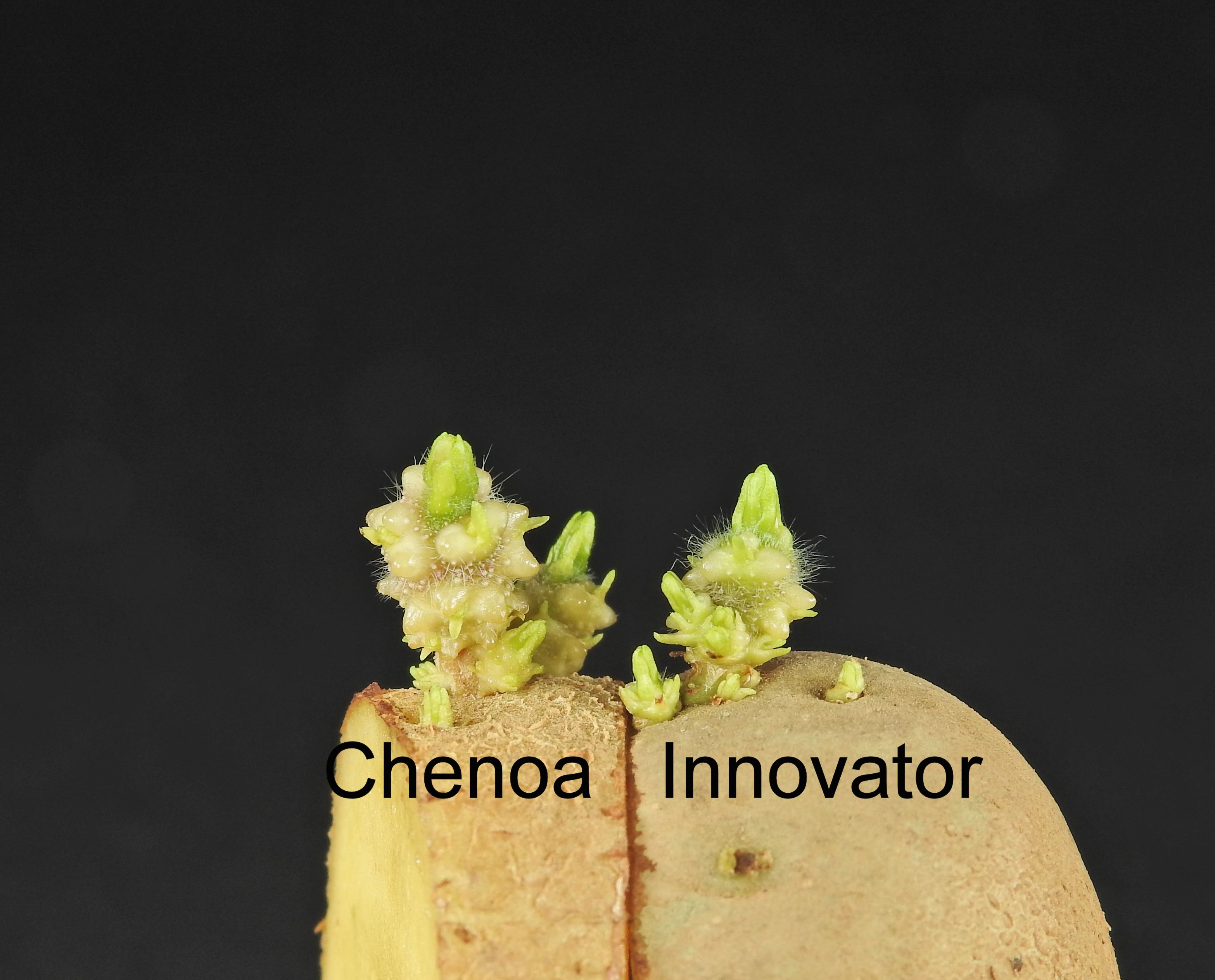Chenoa
| Denomination: | 'Chenoa' |
|---|---|
| Botanical Name: | Solanum tuberosum |
| Applicant/Holder: |
Interseed Potatoes GmbH Gro▀ Charlottengroden 6b Wittmund 26409 Germany |
| Breeder: |
Arne Rehnert, Interseed Potatoes GmbH, Wittmund, Germany |
| Agent in Canada: |
Rockyview Nuclear Tuber Ltd. 263145 TWP262 Rocky View Country, Alberta T4A3A9 Canada Tel: 403-312-0703 |
| Application Date: | 2022-04-08 |
| Provisional Protection:: | 2022-04-08 |
| Application Number: | 22-10882 |
Variety Description
Variety used for comparison: 'Innovator'
Summary: The base of the lightsprout of 'Chenoa' has an absent or low proportion of blue in the anthocyanin colouration while that of 'Innovator' has a medium proportion of blue in the anthocyanin colouration. The stem of 'Chenoa' has a low to medium extent of anthocyanin colouration whereas that of 'Innovator' has an absent or very low extent of anthocyanin colouration. The upper side of the leaf of 'Chenoa' is medium to dark green while that of 'Innovator' is light to medium green. The second pair of lateral leaflets of 'Chenoa' are large in size whereas they are medium sized for 'Innovator. The terminal and lateral leaflets of 'Chenoa' have an absent or very low frequency of coalescence while those of 'Innovator' have a medium frequency of coalescence. The plants of 'Chenoa' are taller than those of 'Innovator'. The plants of 'Chenoa' mature late to very late in the season while those of 'Innovator' mature mid-season. The tuber of 'Chenoa' is long-oval in shape whereas it is long for 'Innovator'.
Description:
LIGHTSPROUT: medium sized, broad cylindrical, medium number of root tips, short lateral shoots
LIGHTSPROUT BASE: weak intensity of anthocyanin colouration, absent or low proportion of blue in anthocyanin colouration, medium pubescence
LIGHTSPROUT TIP: small in relation to base, closed habit, absent or very weak intensity of anthocyanin colouration, sparse pubescence
PLANT: foliage structure is intermediate type where foliage is half open and stems are partly visible, semi-upright growth habit, matures late to very late season
STEM: low to medium extent of anthocyanin colouration halfway up the stem
LEAF: medium to large outline, intermediate to open, weak to medium presence of secondary leaflets, medium to dark green upper side, low extent of anthocyanin colouration on upper side of midrib, absent or very weak to weak intensity of anthocyanin colouration on upper side of midrib, absent or very low frequency of coalescence of terminal and lateral leaflets
SECOND PAIR OF LATERAL LEAFLETS: large, leaflet is narrower than long
LEAFLET: weak degree of waviness of margin, medium depth of veins, medium glossiness of upper side
PEDUNCLE: absent or very low extent of anthocyanin colouration
INFLORESCENCE: high frequency per plant, medium sized
FLOWER BUD: absent or very low extent of anthocyanin colouration
COROLLA: large
COROLLA (INNER SIDE): absent or very weak intensity of anthocyanin colouration, absent or low proportion of blue in anthocyanin colouration, absent or very low extent of anthocyanin colouration
TUBER: long-oval, light yellow flesh
TUBER EYE: shallow depth, yellow at base
TUBER SKIN: light beige
Origin & Breeding History: 'Chenoa' (experimental designation ISP 16-14-08) originated from a hybridization conducted at the Interseed Potatoes GmbH breeding station in Wittmund, Germany in 2008. The cross was made between the varieties 'Miss Bianka', as the female parent, and 'ISP 17-1-01', as the male parent. Seed from the cross was planted in a greenhouse in 2009. The resulting tubers were harvested and planted in the field in Wittmund, Germany in the spring of 2010. The new variety was selected from these progeny in 2010 based on its agronomic characteristics and resistance to various diseases.
Tests & Trials: The comparative trial for 'Chenoa' was conducted by Global Agri Services Inc. in Central Blissville, New Brunswick during the 2022 growing season. The field trial consisted of a single, 22 metre long row per variety. Each row contained 70 plants spaced 0.3 metres apart with inter-row spacing of 1.1 metres. Measurements were taken from 10 plants, or 10 parts of plants, of each variety. The mean difference was significant at the 5% probability level based on a paired Student's t-test. Lightsprout characteristics were assessed on 10 tubers harvested from the comparative trial and observed approximately 2.5 to 3 months after sprouting was promoted by exposing the tubers to an external agent.
Comparison table for 'Chenoa' with reference variety 'Innovator'
Plant height (cm)
| 'Chenoa' | 'Innovator' | |
|---|---|---|
| mean | 63.4 | 52.7 |
| std. deviation | 6.4 | 3.0 |
Click on image for larger view

Potato: 'Chenoa' (left) with reference variety 'Innovator' (right)
- Date modified: